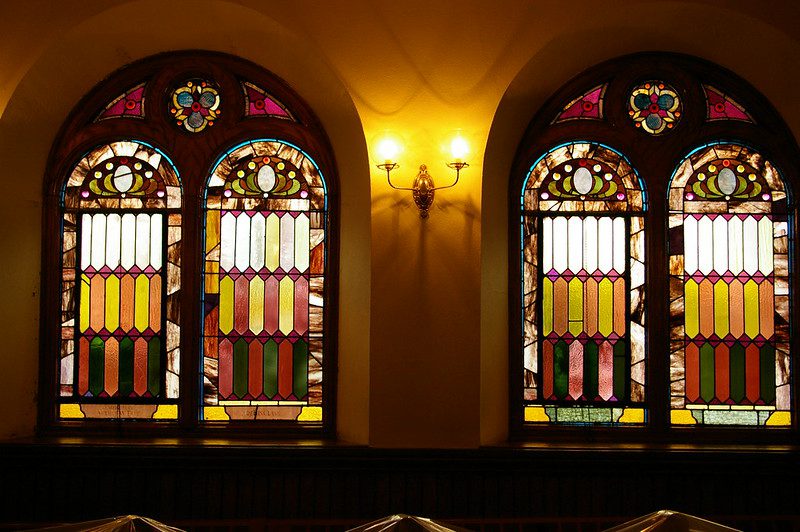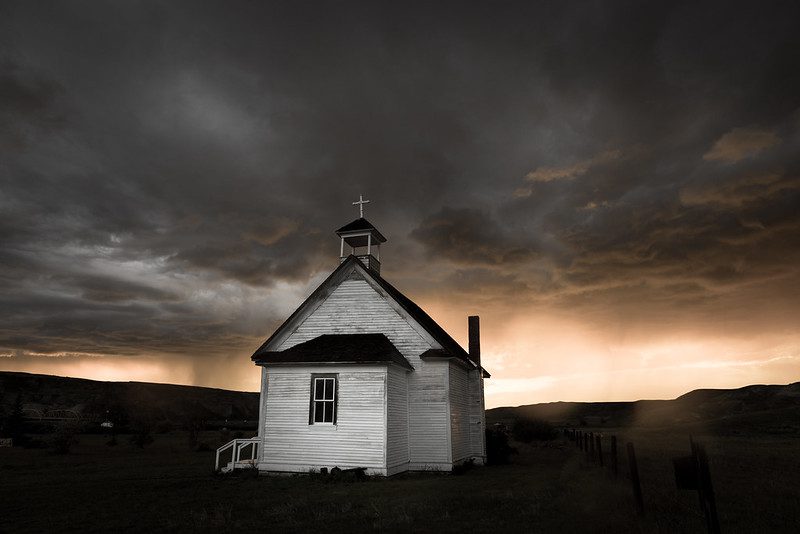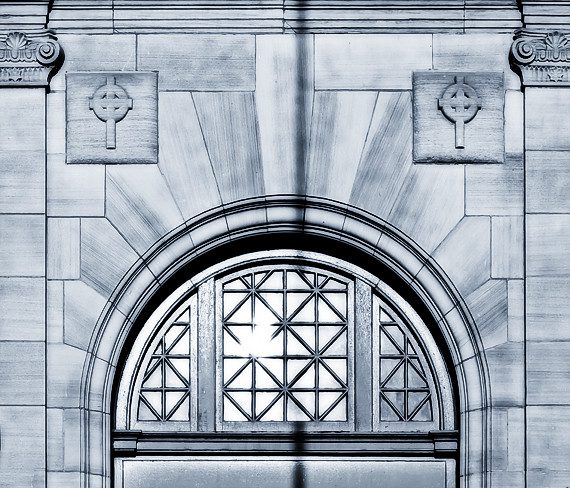
Windows in the Mother Bethel American Methodist Episcopal Church sanctuary, Philadelphia. Photo by Flickr user Michelle Spomer, CC BY-NC 2.0
When people discuss “faith-based community development,” they often jump directly into a conversation on the special role of faith-based groups, assuming that the meanings of “community” and “development” are well-defined, universally understood and constant. They may even think, given the recent surge of Black church participation in the fields of housing and economic development, that faith-based community development is something new. But if we take into account the changing historical understandings of “community” and “development” among Black churches, we see that these institutions have figured prominently in African-American community development for more than two centuries.
There has never existed a homogeneous Black community or a universal Black church to defend it. Nor has there ever been a universally accepted understanding of “development.” The history of Black church-based community development is a history of diverse institutions championing a kaleidoscopic variety of African-American concerns, which themselves have been rooted in broader political, social, and economic contexts that are always shifting. This essay briefly reviews Black churches’ changing definitions of “community” and “development,” and then describes a contemporary mismatch between some of these definitions and popular understandings of “community development.”
This Isn’t New
Throughout slavery, Blacks formed religious congregations in secret. At that time, the size and composition of Black communities were, to a large extent, dictated by the whims of the plantation slave system, and faith-based development meant fighting the great absurdity of slavery with ideas and concrete acts of resistance. It meant, among other things, presenting Blacks as full humans, beloved of God and central protagonists in the divine drama of history, not as sub-humans alien to God and godliness. After the Civil War, slavery began to lose some of its power over Black social organization, and churches became the not-so-secret centers of Black community life.
Meanwhile northern Blacks openly organized quasi-religious mutual aid societies. During the slave era, “community” referred to populations of precariously free Blacks, and development activities promoted cooperative economics, educational advancement, and the abolition of slavery. From these faith-based organizing efforts sprang countless African-American social, economic, and political institutions, including schools, insurance companies, banks, and social service organizations.
In at least one case, a mutual aid society gave birth to a formal church and denomination – the Free African Society, founded in Philadelphia by Richard Allen and Absalom Jones in 1787. From its inception, the Society prioritized “community development” in the form of abolitionism and solidarity-building among free blacks. In 1794 the Society spawned the Mother Bethel African Methodist Episcopal Church, the flagship congregation of this nation’s first independent African-American denomination. Later, the AME denomination formed the first Black publishing house, and its leader, Richard Allen, organized several national anti-slavery “Negro Conventions.” Bethel and other northern churches also linked to form stations on the Underground Railroad.
From the late 19th to the middle of the 20th century, waves of migration brought millions of rural Blacks to cities and southern Blacks to the north. In response, much of Black religious life was reorganized along class, regional, and theological lines. Churches of middle-class Blacks, poor Blacks, northern Blacks, southern Blacks, foreign-born Blacks, Pentecostal Blacks and “mainline” Blacks emerged, each serving a distinct target population.
Likewise, church-based community development grew more diverse because religious people had widely varying responses to issues of the day. For instance, some of the long-standing churches of northern Blacks, many of which were middle class and Baptist or Methodist, tried to acclimatize recent migrants to northern life through a variety of educational services, including training on how to behave in public settings. Others largely ignored the newcomers, choosing instead to “advance the race” by cultivating their own cultural, intellectual, and economic capacities. Meanwhile, churches of poor southern migrants – which eventually came to include countless Pentecostal congregations – coordinated travel, found jobs, and provided temporary lodging for newcomers, in addition to offering oases of southern spirituality and sociability. In the same period, the birth of secular Black community development entities such as the NAACP and the Urban League provided entirely new outlets for socially concerned religious Blacks. These groups would also provide new arenas for ongoing debates over the very meaning of racial community, and the goals of racial advancement.
Community and Neighborhood
In the 1950s and ’60s, the “community” in community development became strongly associated with urban neighborhoods, and “development” became associated almost exclusively with economic and social service endeavors. During this period, continued Black northward migration and civil rights gains in the housing arena altered the racial and economic makeup of countless residential neighborhoods in major northern cities and led to a national preoccupation with the fate of urban neighborhoods. Federal poverty policy turned toward neighborhoods with the Economic Opportunity Act of 1964. The EOA, with its “maximum feasible participation” rhetoric and neighborhood-based Community Action Programs, became the centerpiece of Lyndon Johnson’s War on Poverty.
In policy circles, “community” became defined along highly local geographic lines. “Development,” which had always included political resistance and policy advocacy in its repertoire of strategies, now focused mainly on social and economic projects. In this national policy environment, all sorts of local organizations, including churches, came to view neighborhood initiative as the most legitimate way to address urban problems. Hundreds of local Black institutions became neighborhood-based agents of the state.
Since the ’60s, urban poverty rates have ballooned, and government interest in neighborhood-based solutions is still strong, if not stronger. Meanwhile Black churches, which once gave birth to countless other institutions, now tend to be the only viable institutions left in depressed Black locales. Often they are the only civic spaces where people meet regularly to share experiences, hopes, plans. And popular concern about the deterioration of society’s “moral fabric” has reached fever pitch. Together, these circumstances have put tremendous pressure on Black churches to play major roles in the resurrection of economically, physically, and sometimes socially devastated neighborhoods.
Are Black Churches Neighborhood Institutions?
Many of the most celebrated examples of Black church-based community development involve a single church, usually a large and well-financed one, taking charge of a single neighborhood and attracting the resources necessary to rebuild that neighborhood’s economic and physical infrastructure. Such examples, however inspiring, tempt us to view Black churches as traditional parishes where congregants come from the neighborhood and religious community is the same as geographic community. Recall, however, that Black religious notions of community and development have never been so static or narrow. Churches are not necessarily neighborhood institutions.
Churches often pull people together around common ethnicity, regional or national origin, class background, political orientation, life stage, or lifestyle. Less often do congregations form around shared neighborhood identity. Many churches draw membership from a geographic area much wider than the immediate neighborhood. People pick churches according to social identity more than spatial proximity. One Black congregation, then, might primarily consist of educated middle-class professionals, while another consists of working-poor people. One church may attract southern migrants, while another appeals mainly to native northerners. Another church might serve Haitians or West Indians rather than Blacks born in the United States. None of these churches need be located where their target populations live; as long as the church isn’t too far away, people will “commute” to worship where they feel at home. This is why we sometimes see solid middle-class Black churches located in poor Black neighborhoods. It also partly explains how dozens of churches can concentrate in a very small, economically depressed area, forming what I call a “religious district.” Churches can locate quite near each other, all taking advantage of cheap rents in otherwise vacant commercial spaces, because they are not competing for neighborhood residents per se.
So Black churches that fail to respond to calls for neighborhood-based community development may not be “otherworldly” or apolitical. They may simply be placing a priority on the immediate concerns of congregation members or communities of interest that transcend the neighborhood. These concerns and interests certainly can overlap with those of neighborhood residents. Church members, their families and their friends may need job training, jobs, affordable housing, educational opportunities, immigration services, and so on. But not every church will intuitively think of these as neighborhood needs worth fighting for at the neighborhood level.
In addition, churches that do not identify with their immediate neighborhoods probably will not feel obliged to associate with neighboring religious organizations. They are just as likely to link with similar churches located in other neighborhoods. For instance, in Boston, Haitian protestant churches have joined across neighborhoods to form a mutual support network, not unlike the pre-existing, and predominantly African-American, Black Ministerial Alliance. Churches have also formed trans-neighborhood activist coalitions. Two very prominent examples in Boston are the Ten Point Coalition and the Greater Boston Interfaith Organization. Both are organizations of churches involved in social, economic or political activities. Neither is a neighborhood organization: member churches are located in various quarters of the city, and some even hail from the suburbs. Rather than responding to a shared neighborhood identity, participating congregations are drawn together by their shared belief that churches, or Black churches in the case of Ten Point, should be agents of social, economic, and political change in urban centers.
This has policy implications. Policymakers should not take the famous cases of one-church one-neighborhood development to be the norm, and therefore push churches to spearhead the next wave of place-based Community Action Programs. Many poor neighborhoods have no native institutional advocates – religious or otherwise. In the heated competition over limited revitalization resources, such locales will continue to fall through the cracks, until urban policies begin to target them. What are sorely needed are local and federal urban policies that account for the neighborhood-specific aspects of poverty and economic depression, yet recognize the citywide social orientations of many churches and other institutions.
Trans-Neighborhood Faith-Based Development
Community development groups that organize across neighborhoods are promising in this regard. Such groups take best advantage of the way many churches think of themselves and their network-building activities: as locally based, but not neighborhood focused. Rather than focusing entirely on one neighborhood or another, these initiatives can highlight the common plight of multiple poor neighborhoods and challenge undesirable urban policies. At the same time, such groups can encourage churches to notice and become active in immediate neighborhood affairs. This may be an especially useful way to pull wealthier “commuter” churches into the struggles of the poor areas where they sometimes locate.
Examples of such work in Boston include Mattapan-Dorchester Churches in Action and the famed Ten Point Coalition. Mattapan-Dorchester Churches in Action formed in 1989 to “challenge power structures which prevent our neighborhoods from achieving their fullest potential.” Their efforts focus on political advocacy, voter registration, crime prevention, and affordable housing development in multiple neighborhoods. Ideas for specific efforts and campaigns “bubble up” from member churches, where “action committees” continually assess the concerns and needs of local residents.
A handful of ministers established the Ten Point Coalition in 1988 after a gang-related fight erupted inside a church, ironically, during the funeral a young victim of gang violence. The ministers concluded that “because the church has not been brought into the street, the street has been brought into the church,” and drafted the “Ten Point Proposal for Citywide Church Mobilization to Combat the Material and Spiritual Sources of Black-on-Black Violence.” Members of the Coalition, located all over the metropolis but especially in poor Black neighborhoods, have adopted one or more of the various court advocacy, youth outreach, voter registration, and economic development programs outlined in the proposal. Ten Point has been especially successful at redistributing material wealth and other resources from concerned suburban and “downtown” congregations to churches doing anti-poverty and anti-violence work in poor neighborhoods.
The challenge, then, is to discover community development practices and policies that build on the actual institutional strengths of Black churches, and religious institutions in general. This means we cannot assume Black churches to be model neighborhood institutions, ever poised to “save” their residential neighbors. Black churches, like most organized religious bodies, are richly diverse institutions engaged in complicated relationships with populations, neighborhoods, and cities. Thus, “community” does not always mean “neighborhood.” Likewise the “development” spearheaded by Black churches sometimes transcends the needs of particular neighborhoods, as when churches highlight the plight of urban poor people in general. This strategy can be an asset, especially in urban economies that force poor neighborhoods to compete for resources that, ideally, all would enjoy.





Comments